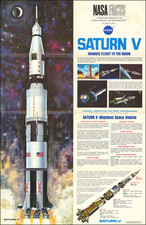This compelling photograph captures the deployed Apollo Lunar Surface Experiment Package (ALSEP) during the Apollo 12 mission on November 19, 1969. In this northwest-looking view, the lunar surface magnetometer experiment takes the foreground, while other objects on the lunar surface are visible from right to left: a discarded subpallet and cover; the solar-wind spectrometer experiment; the suprathermal ion detector experiment, with the darker radioisotope thermoelectric generator behind it; the ALSEP central station, where Astronaut Charles Conrad Jr., the mission commander, is adjusting the antenna; the passive seismic experiment (PSE); and the discarded PSE girdle. The boot prints of Astronaut Alan L. Bean, the lunar module pilot, can be seen as he traversed the crater. The photograph was taken during the first extravehicular activity (EVA-1) using an HCEX (SO-168 - Ektachrome EF, high-speed color reversal, ASA 160) film with a 60mm lens. The sun angle was low, and the camera tilt was a medium oblique with a westward direction.
This photo appeared in the series AS12-46-6715 through AS12-57-8455b, though it is a reverse image of he one typically seen.
Apollo 12 was the sixth crewed flight in the United States Apollo program and the second to land on the Moon. It was launched on November 14, 1969, from the Kennedy Space Center, Florida, four months after Apollo 11. Commander Charles "Pete" Conrad and Apollo Lunar Module Pilot Alan L. Bean performed just over one day and seven hours of lunar surface activity while Command Module Pilot Richard F. Gordon remained in lunar orbit. The landing site for the mission was located in the southeastern portion of the Ocean of Storms.











![(Los Angeles Architecture) [Photograph of a 1920s Spanish Colonial Revival home, likely in the Hollywood Hills area; with glass plate negative]](https://storage.googleapis.com/raremaps/img/small/96755.jpg)
![(Apollo 14 - Recovery Tracking Manuscript) [Post lunar landing recovery map and related ephemera from aboard USS New Orleans including NASA issued Apollo 14 insignia patch] Apollo Mission Plotting Chart (AMP) 4th Apollo Edition, January 1969.](https://storage.googleapis.com/raremaps/img/small/76611.jpg)

![(San Diego Photograph) 225. San Diego Mission. Oldest in the State. Established 1769 [Original boudoir card format albumen photograph of San Diego Mission and St. Anthony's Indian School Girl's Dormitory]](https://storage.googleapis.com/raremaps/img/small/92622.jpg)
![(Honolulu Stereoview) Honolulu from Punchbowl [Original stereocard photograph birdseye view of Honolulu, Hawaii]](https://storage.googleapis.com/raremaps/img/small/92950.jpg)
![[Ion Powered Spacecraft Traveling To Mars]](https://storage.googleapis.com/raremaps/img/small/83629.jpg)